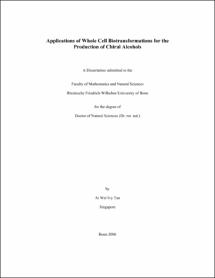Tan, Ai Wei Ivy: Applications of Whole Cell Biotransformations for the Production of Chiral Alcohols. - Bonn, 2006. - Dissertation, Rheinische Friedrich-Wilhelms-Universität Bonn.
Online-Ausgabe in bonndoc: https://nbn-resolving.org/urn:nbn:de:hbz:5N-07579
Online-Ausgabe in bonndoc: https://nbn-resolving.org/urn:nbn:de:hbz:5N-07579
@phdthesis{handle:20.500.11811/2614,
urn: https://nbn-resolving.org/urn:nbn:de:hbz:5N-07579,
author = {{Ai Wei Ivy Tan}},
title = {Applications of Whole Cell Biotransformations for the Production of Chiral Alcohols},
school = {Rheinische Friedrich-Wilhelms-Universität Bonn},
year = 2006,
note = {Bioreduction of (2,5)-hexanedione to highly enantiopure (5R)-hydroxyhexane-2-one (ee > 99 %) with Lactobacillus kefiri DSM 20587 was investigated. Cell immobilisation with sodium cellulose sulphate (technical grade) was chosen as the most suitable encapsulation matrix, giving an immobilisation yield of 40%. Despite the lowered biocatalytic activity from cell immobilisation, the bioreduction process was vastly improved with the help of reaction engineering techniques (batch to a plug flow reactor setup). High selectivity (95 %) and space-time yield (87 g L-1 d-1), with a biocatalyst consumption of 1.4 gwcw g-1 was achieved in the plug flow reactor. The biocatalyst remained active (68 % residual activity) after 6 days of operation. Downstream processing of (5R)-hydroxyhexane-2-one was obtained by column chromatography, yielding a product of more than 99 % purity (GC) and enantiomeric excess on a gram-scale.
The same bioreduction was applied on an enzyme-coupled system consisting of alcohol dehydrogenase from Lactobacillus brevis (LbADH) and formate dehydrogenase (FDH) from Pseudomonas sp. In a similar enzyme-coupled system, the biotransformation was extended from a batch to a continuous setup to reduce methyl acetoacetate to highly enantiopure (R)-methyl 3-hydroxybutanoate (ee > 99 %). The highest total turnover numbers (2.4 x 106 mol molADH-1, 2.5 x 104 mol molFDH-1 and 329 mol molNADP-1) and therefore, lowest biocatalyst consumption (0.015 gADH+FDH g-1) was achieved in the continuous setup.
From an enzyme-coupled system to whole cell biotransformation of methyl acetoacetate with genetically modified Escherichia coli coexpressing genes of LbADH and FDH from Mycobacterium vaccae, high enantiopure (R)-methyl 3-hydroxybutanoate (ee > 99 %) was also obtained. Through reaction engineering, the lowest biocatalyst consumption (0.9 gwcw g-1) was yielded in a continuous reactor. The biocatalyst deactivated rapidly (kdes of about 5 % h-1) under continuous production, possibly due to a leaky cell membrane.
In this study, comparison of the whole cells and enzyme-coupled systems revealed higher activities for enzyme-coupled bioreductions with high production costs. Although whole cells biotransformations yielded lower activities, they are more inexpensive. Through reaction engineering techniques, the biocatalyst consumption of whole cell bioreductions could be reduced. In addition, the biocatalyst consumption of a process can be further reduced with whole cell immobilisation.},
url = {https://hdl.handle.net/20.500.11811/2614}
}
urn: https://nbn-resolving.org/urn:nbn:de:hbz:5N-07579,
author = {{Ai Wei Ivy Tan}},
title = {Applications of Whole Cell Biotransformations for the Production of Chiral Alcohols},
school = {Rheinische Friedrich-Wilhelms-Universität Bonn},
year = 2006,
note = {Bioreduction of (2,5)-hexanedione to highly enantiopure (5R)-hydroxyhexane-2-one (ee > 99 %) with Lactobacillus kefiri DSM 20587 was investigated. Cell immobilisation with sodium cellulose sulphate (technical grade) was chosen as the most suitable encapsulation matrix, giving an immobilisation yield of 40%. Despite the lowered biocatalytic activity from cell immobilisation, the bioreduction process was vastly improved with the help of reaction engineering techniques (batch to a plug flow reactor setup). High selectivity (95 %) and space-time yield (87 g L-1 d-1), with a biocatalyst consumption of 1.4 gwcw g-1 was achieved in the plug flow reactor. The biocatalyst remained active (68 % residual activity) after 6 days of operation. Downstream processing of (5R)-hydroxyhexane-2-one was obtained by column chromatography, yielding a product of more than 99 % purity (GC) and enantiomeric excess on a gram-scale.
The same bioreduction was applied on an enzyme-coupled system consisting of alcohol dehydrogenase from Lactobacillus brevis (LbADH) and formate dehydrogenase (FDH) from Pseudomonas sp. In a similar enzyme-coupled system, the biotransformation was extended from a batch to a continuous setup to reduce methyl acetoacetate to highly enantiopure (R)-methyl 3-hydroxybutanoate (ee > 99 %). The highest total turnover numbers (2.4 x 106 mol molADH-1, 2.5 x 104 mol molFDH-1 and 329 mol molNADP-1) and therefore, lowest biocatalyst consumption (0.015 gADH+FDH g-1) was achieved in the continuous setup.
From an enzyme-coupled system to whole cell biotransformation of methyl acetoacetate with genetically modified Escherichia coli coexpressing genes of LbADH and FDH from Mycobacterium vaccae, high enantiopure (R)-methyl 3-hydroxybutanoate (ee > 99 %) was also obtained. Through reaction engineering, the lowest biocatalyst consumption (0.9 gwcw g-1) was yielded in a continuous reactor. The biocatalyst deactivated rapidly (kdes of about 5 % h-1) under continuous production, possibly due to a leaky cell membrane.
In this study, comparison of the whole cells and enzyme-coupled systems revealed higher activities for enzyme-coupled bioreductions with high production costs. Although whole cells biotransformations yielded lower activities, they are more inexpensive. Through reaction engineering techniques, the biocatalyst consumption of whole cell bioreductions could be reduced. In addition, the biocatalyst consumption of a process can be further reduced with whole cell immobilisation.},
url = {https://hdl.handle.net/20.500.11811/2614}
}






